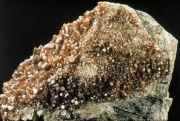Difference between revisions of "Lead vanadate"
Jump to navigation
Jump to search
(username removed) |
|||
| (One intermediate revision by one other user not shown) | |||
| Line 8: | Line 8: | ||
lead metavanadate; vanadinite; vanadato de plomo (Esp.); vanadate de plomb (Fr.); vanadato de chumbo (Port.) | lead metavanadate; vanadinite; vanadato de plomo (Esp.); vanadate de plomb (Fr.); vanadato de chumbo (Port.) | ||
| − | == | + | == Risks == |
| + | |||
| + | * Toxic by inhalation or ingestion. | ||
| + | * Skin contact may cause irritation or ulcers. | ||
| + | * Carcinogen, teratogen, suspected mutagen. | ||
| + | * ThermoFIsher: [https://www.fishersci.com/store/msds?partNumber=AA3937818&productDescription=LEAD%28II%29+METVANADATE+99.9%25+50G&vendorId=VN00024248&countryCode=US&language=en SDS] | ||
| + | |||
| + | ==Physical and Chemical Properties== | ||
Decomposes in nitric acid. Insoluble in water | Decomposes in nitric acid. Insoluble in water | ||
| Line 24: | Line 31: | ||
|} | |} | ||
| − | == | + | ==Resources and Citations== |
| − | |||
| − | |||
| − | |||
| − | |||
* G.S.Brady, ''Materials Handbook'', McGraw-Hill Book Co., New York, 1971 Comment: p. 444 | * G.S.Brady, ''Materials Handbook'', McGraw-Hill Book Co., New York, 1971 Comment: p. 444 | ||
Latest revision as of 10:37, 7 October 2022
Description
A yellow powder that occurs naturally in the mineral vanadinite. Vanadinite is found in the southwestern United States, Mexico, and Spain. Lead vanadate is used as a pigment in industrial paints.
Synonyms and Related Terms
lead metavanadate; vanadinite; vanadato de plomo (Esp.); vanadate de plomb (Fr.); vanadato de chumbo (Port.)
Risks
- Toxic by inhalation or ingestion.
- Skin contact may cause irritation or ulcers.
- Carcinogen, teratogen, suspected mutagen.
- ThermoFIsher: SDS
Physical and Chemical Properties
Decomposes in nitric acid. Insoluble in water
| Composition | Pb(VO3)2 |
|---|---|
| CAS | 10099-79-3 |
| Molecular Weight | mol. wt. = 405.11 |
Resources and Citations
- G.S.Brady, Materials Handbook, McGraw-Hill Book Co., New York, 1971 Comment: p. 444
- Richard S. Lewis, Hawley's Condensed Chemical Dictionary, Van Nostrand Reinhold, New York, 10th ed., 1993
- The Merck Index, Martha Windholz (ed.), Merck Research Labs, Rahway NJ, 10th edition, 1983 Comment: entry 5451
